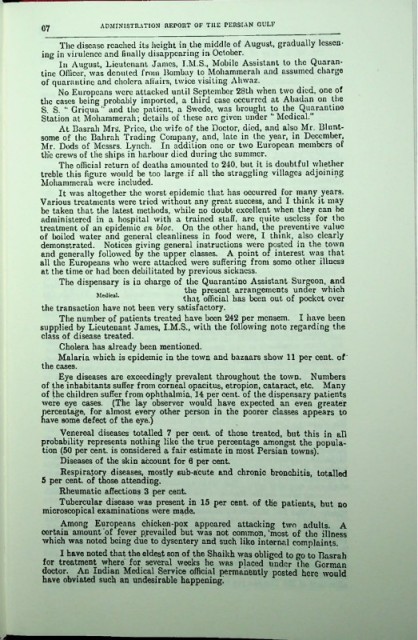Page 669 - PERSIAN 5 1905_1911
P. 669
ADMINISTRATION REPORT OF TIIE PERSIAN GULF
67
The disease reached its height in the middle of August, gradually lessen
ing in virulence and finally disappearing in October.
In August, Lieutenant James, Mobile Assistant to the Quaran
tine Officer, was demited from Bombay to Mohammerah and assumed charge
of quarantine and cholera affairs, twice visiting Ahwaz.
No Europeans were attacked until September 28th when two died, one of
the cases being probably imported, a third case occurred at Abadan on the
S. S. Griqua” and the patient, a Swede, was brought to the Quarantine
Station at Mohammerah; details of these arc given under “ Medical.”
At Basrah Mrs'. Price, the wife of the Doctor, died, and also Mr. Blunt-
some of the Bahrah Trading Company, and, late in the year, in December,
Mr. Dods of Messrs. Lynch. In addition one or two European members of
the crews of the ships in harbour died during the summer.
The official return of deaths amounted to 240, but it is doubtful whether
treble this figure would be too large if all the straggling villages adjoining
Mohammerah were included.
It was altogether the worst epidemic that has occurred for many years.
Various treatments were tried without any great success, and I think it may
be taken that the latest methods, while no doubt excellent when they can be
administered in a hospital with a trained staff, are quite useless for the
treatment of an epidemic en bloc. On the other hand, the preventive value
of boiled water and general cleanliness in food were, I think, also clearly
demonstrated. Notices giving general instructions were posted in the town
and generally followed by the upper classes. A point of interest was that
all the Europeans who were attacked were suffering from somo other illness
at the time or had been debilitated by previous sickness.
The dispensary is in charge of the Quarantine Assistant Surgeon, and
the present arrangements under which
Medical.
that official has been out. of pocket over
the transaction have not been very satisfactory.
The number of patients treated have been 242 per mensem. I have been
supplied by Lieutenant James, I.M.S., with the following note regarding the
class of disease treated.
Cholera has already been mentioned.
Malaria which is epidemic in the town and bazaars show 11 per cent, of
the cases.
Eye diseases are exceedingly prevalent throughout the town. Numbers
of the inhabitants suffer from corneal opacitus, etropion, cataract, etc. Many
of the children suffer from ophthalmia, 14 per cent, of the dispensary patients
were eye cases. (The lay observer would have expected an even greater
percentage, for almost every other person in the poorer classes appears to
have some defect of the eye.)
Venereal diseases totalled 7 per cent, of those treated, but this in all
probability represents nothing like the true percentage amongst the popula
tion (50 per cent, is considered a fair estimate in most Persian towns).
Diseases of the skin account for 6 per cent.
Respiratory diseases, mostly 6ub-acute and chronic bronchitis, totalled
5 per cent, of those attending.
Rheumatic affections 3 per cent.
Tubercular disease was present in 15 per cent, of the patients, but no
microscopical examinations were made.
Among Europeans chicken-pox appeared attacking two adults. A
certain amount of fever prevailed but was not common, ‘most of the illness
which was noted being due to dysentery and such like internal complaints.
I have noted that the eldest son of the Shaikh was obliged to go to Basrah
for treatment where for several weeks he was placed under the German
doctor. An Indian Medical Service official permanently posted here would
have obviated such an undesirable happening!

